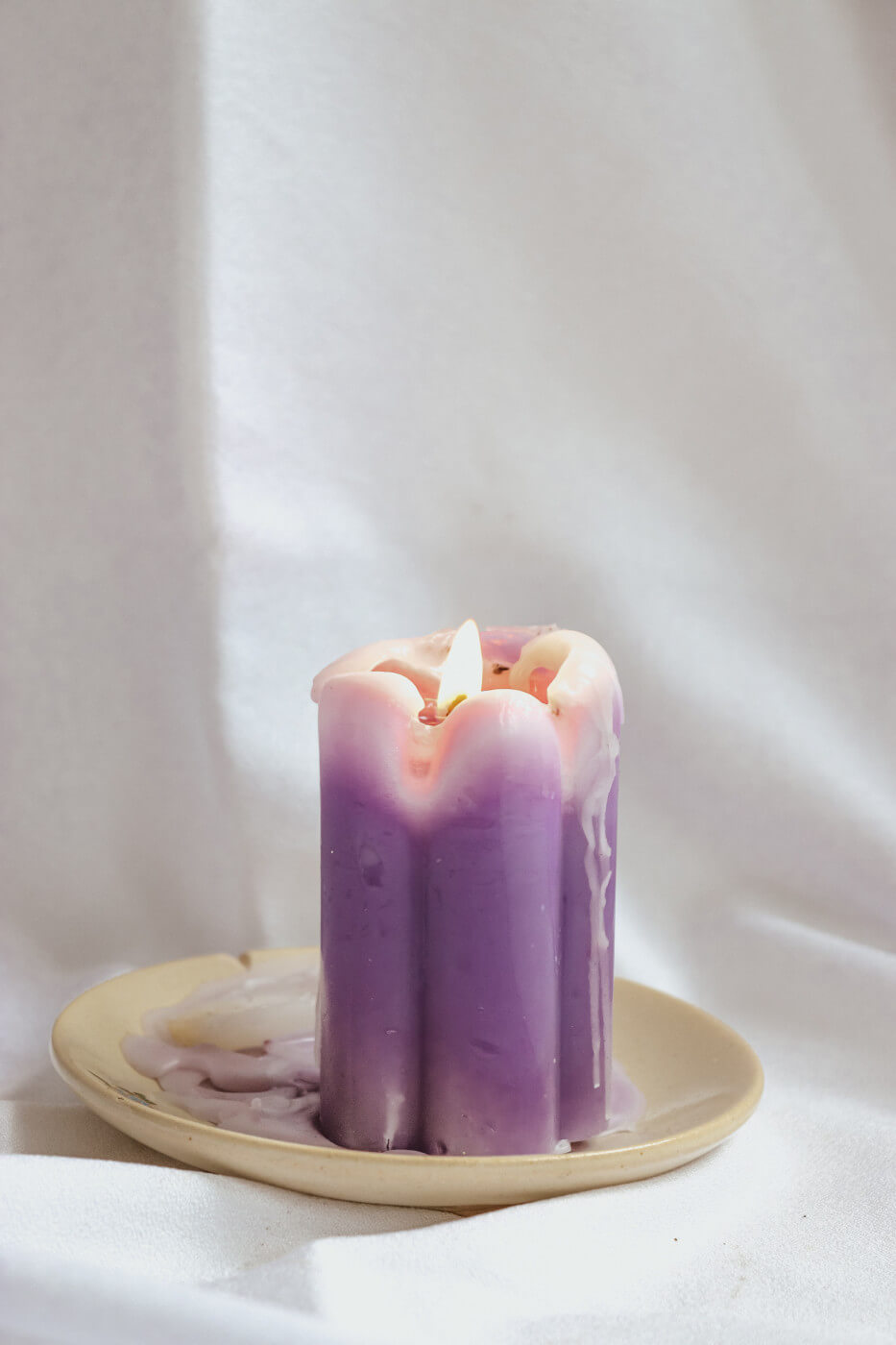WHAT IS CANDLE TUNNELING?
Candle tunneling is already well-known to those who have been lighting candles for a long time. Be that as it may, the people who fostered another interest in candles may not know about flame burrowing.
The candle's center, or the area around the wick, begins to melt, forming a vertical tunnel. Therefore, candle tunneling occurs when the flame penetrates the wax rather than melts the surface in an even manner. When tunneling occurs, the hard wax surrounding the wick melts quickly beneath the wick.
The size of a candle affects how long it takes to burn. The amount of time a candle burn depends on its size. However, tunneling will shorten the burn time and waste the remaining fragrance and wax. Because of tunneling, only the center of the wax can be used; As a result, it quickly sinks to the bottom, leaving the surrounding wax untouched.
WHY DOES TUNNELING HAPPEN?
The majority of people are wrong to believe that cheaper candles cause tunneling. Since tunneling occurs in even the most expensive candles, the cost is not the most important consideration here.
Inappropriate wick size, wax type, and bad candle-burning habits are the two primary causes of tunneling. The size of the wick can make or break a candle, even though most people ignore it. Wicks should be thicker for larger candles and thinner for smaller ones. However, large candles typically have small wicks, resulting in tunneling. Tunneling occurs when small wicks are unable to evenly melt the surface.
As a result, when purchasing candles, you must check the size of the wick. I also mentioned bad burning habits as a reason. The first time your candle burns is the most common indicator of poor candle-burning habits. What is the significance of a candle's first burn?
To evenly melt the surface, you must burn your candles for a sufficient amount of time (at least 15 minutes of burn time). This mistake is frequently made by people who don't wait long enough before blowing out their candle during the first burn. In most cases, it takes between one and two hours for large candles to melt the entire surface. Your candle will indeed have tunneled if you do not do this.
But why should you allow the surface to completely melt? Because, even in its solid state, wax is not as hard as it appears to be. A candle that was lit a week ago will be drier than wax that was burned two days ago.
Therefore, if you burn your candle too quickly the first time, only the center of the wax will melt, leaving the rest of the candle hard. The candles don't appear to be in different solid states, but the center is softer and less hard than the surrounding area.
Therefore, during your second or third burn, the softer part, also known as the center, will continue to melt while the other parts remain solid, resulting in tunneling.
HOW TO PREVENT TUNNELING?
The best way to prevent candle tunneling is to take proper care of your wick. A wick that has been burned down too far can cause a tunneling effect because it can't support itself in its new position. If your candles are tunneling and you've checked for all the other possible causes, here are some tips for keeping your wicks straight:
1. Trim the Wick
Trim the wick before each use to ensure that there are no stray wicks sticking out of your candle that could cause tunneling issues. It is suggested to trim the wick every 4 hours of burn time. One-quarter inch each time the candle is lit is good enough to help control the tunneling.
2. Use Lighter or Long Matches
You can safely and more easily reach the candle's wick with a lighter or longer match. You'll also be able to start a burn evenly with this. When using short matches, people frequently tilt the candle in their hands to make it easier to reach the wick. This causes the flames to flicker, and the wax will begin melting unevenly right away.
3. Spread the Wax Out Completely
Always wait until the upper wax layer has melted all the way across the candle's surface area before blowing it out. You will avoid what is commonly referred to as tunneling by achieving a full melt. At this point, the wick begins to lower itself, forming a sort of tunnel that runs all the way through the center of the candle. You might not even be able to light the wick at all if this tunnel gets too deep at times. Additionally, it is unfortunate that all of the unmelted wax on the tunnel's sides is being wasted. When lighting a candle for the first time, it is especially crucial to melt the entire upper layer of wax. Memory rings are usually left behind, and if you let this happen, when the candle is lit again, it will burn the same way. Consequently, the melted wax will continue to narrow, eventually forming a tunnel. As a result, it's critical to follow the same procedure each time you light a candle. Therefore, to ensure an even upper layer, always allow the entire top layer to melt.
4. Avoid Drafts
When the flame begins to flicker, the primary issue with candles burning unevenly is present. Therefore, you should avoid placing the candle in a location where it will be affected by drafts or breezes. Therefore, lighting a candle in an open window or close to an air conditioner is not a good idea. Additionally, this is significant from a safety standpoint.
5. Avoid Blowing Out the Flame
Unaware of the fact that this is best avoided, many people accidentally blow out candles in order to put out the flame. However, putting out the fire is preferable to blowing it out. When you blow, you end up dispersing ashy particles into the melted wax of the candle.
Therefore, using a candle snuffer directly on the flame and gradually lowering it until it is just above the pool of melted wax is preferable. Keep it there for about three seconds to give the flame time to burn out and use up the oxygen. You can also use a metal spoon if you don't have a candle snuffer. A fireproof lid may also be included with some candles. The fire can be put out with this.
Sprinkle some salt on the melted wax for a second effective way to properly extinguish candles. Because this slows the wax's melting rate, you should be able to achieve a slower burn and a more even result. Iodized table salt is very effective. Using a toothpick, you can mix it into the candle's liquid wax. The upper layer of the candle should be more even once the wax has completely cooled. Because it can help you achieve a more even burn and extend the amount of time you can use the candle, this procedure can be carried out following subsequent burns.
6. Don’t Use Water
Some people use water to put out the fire. However, putting out candles this way is neither safe nor practical. The candle will be splashed with water, which will also splash hot wax. Your hand, the candle holder or jar, and even the surface where the candle is could all be burned by this.
7. Reuse After Cooling
Before lighting the candle again, it is very important to always allow the wax to completely cool. If you want to light a candle that just burned out, make sure the melted wax has sufficiently hardened.
8. Cover if Not in Use
If candles are not being used, they should be covered. Dust can cause more smoke and crackling as well as an uneven burn. Therefore, if you do not intend to use candles, either put them away in a drawer or cupboard. Better still, cover them or put them in the freezer.
HOW TO FIX TUNNELING?
Candle tunneling can be fixed most effectively by preventing it in the first place. Additionally, it is very simple.
Burning your candle for a sufficient amount of time each time will melt the entire top surface of the wax, preventing tunneling. When you burn your candle for the first time, this is especially important!
The duration largely depends on the candle's size. Keep in mind that your candle should be burned for one hour for every inch of its diameter. Therefore, if the diameter of your candle is 3 inches, you should prepare to allow it to burn for 3 hours prior to lighting it.
Here are some tricks that might help fix your candle from tunneling.
1. Hairdryer
Candle tunneling can be successfully recovered using a hair dryer. However, you should first trim the wick and clear the surface of any debris. Heat the entire surface by switching to the hair dryer's lowest setting first. You can gradually switch to the dryer's highest setting. Keep heating until the entire surface begins to melt. Now light the candle and wait at least 30 minutes for it to burn out before blowing it out. Before burning the wax again, allow it to harden for two days. |
 |
2. Aluminum and Foil
By heating the sides of your wax and letting them melt, this method works. Trim the wick and remove any debris from the surface, as in the previous method. Wrap a piece of foil paper around the candle now. Cover the candle's top. Make a hole in the middle that is big enough to let the heat out. To melt the entire surface, burn the candle for a few hours. Allow the candle to sit for a few days after turning off the flame so that the wax fully solidifies. |
 |
3. Candle Topper
Open metal lids that look cute and often have intricate designs are known as candle toppers. They help ensure that the wax melts evenly by shielding the flames from wind and drafts, just like aluminum foil does. In addition, they are so adorable. You can find everyday designs like this stunning scalloped topper as well as Christmas-themed ones like these with snowmen or snowflakes. Note: Candle toppers work best with single-wicked, larger candles. |
 |
4. Oven
When you spot the tunneling early, this method works best. Place your candle in the oven and turn it to the lowest setting. Before removing it, wait until the entire surface has melted. In between, you should look to see how the melting is going. |
 |
5. Trim the Wax
You might wonder, "What does trimming wax surface even mean?" if this sounds a little odd. Well, it's just scraping off the part of the candle that hasn't burned to level it out. Remove the unmelted wax with a knife or the back of a spoon—make sure these are clean. It will function as if you were lighting the first candle. Let the candle burn for a while after removing the unmelted wax until the entire surface is melted. |
 |
TAKEAWAY:
If you follow these steps, you should be able to save your candle tunneling situation! Lucky for you, all our candles have MINIMAL tunneling which shouldn't even be a problem in the first place.
Check out our candle collection here. We sell candles that burn clean and have a clean, non-stuffy scent. Each candle is made with wooden wicks and coconut soy wax.


